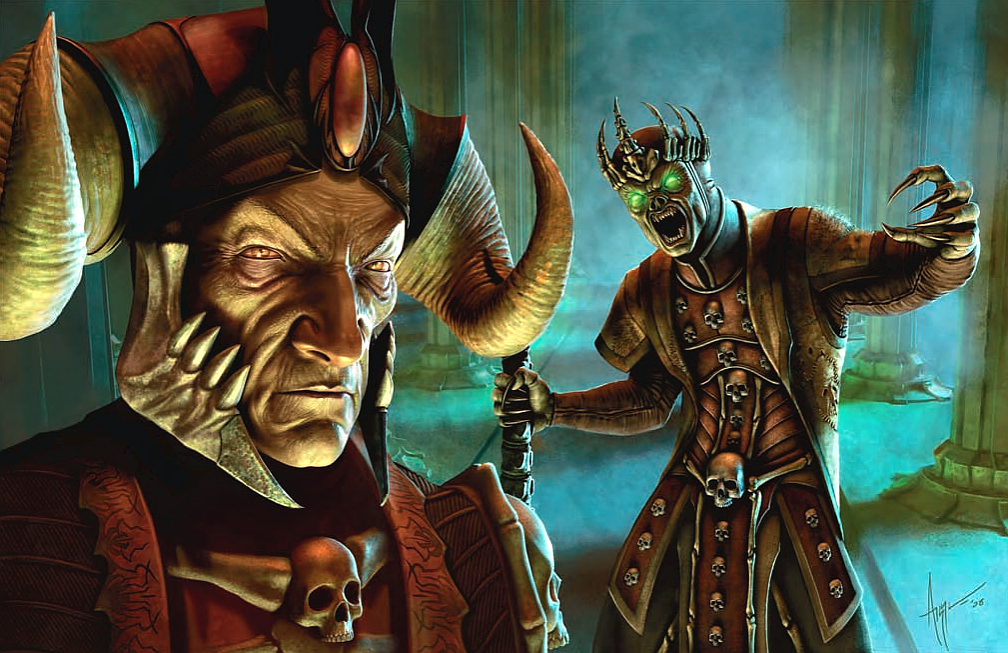

Notable settlements are described next, followed by two or three plot hooks. Each region begins with a brief overview, followed by a lore section with various bits that can be learned by characters via skill checks. Most of the book is dedicated to describing the various regions of the Realms with each one receiving a two page write up. This area also allowed the introduction of the new races from the Player's Handbook, for example the dragonborn are the predominant servants of the dragons on Returned Abeir. The new continent of Returned Abeir offers a distinct contrast to Faerun as most of the continent is ruled by dragons or rebellious humanoid servants of dragons. The most significant change is that the power of most of the nations has been greatly reduced to fit with the "points of light" design theme. There are still many different cultures in the Realms, most being modelled on real world ones. Some of the places removed, such as Unther and Mazteca felt out of place in the Realms and with their removal the focus was refined.


The geographic changes were very welcome. This reviewer feels that it was taken too far as he enjoyed the larger pantheon and the idea that older demihuman gods were simply aspects of human gods did not sit well either. All of this change was intended to prune the pantheon and bring it in line with the new core D&D cosmology.

Gods were killed, some entities were merged or revealed as simply aspects of other deities, and still other gods revealed themselves as Primordials. In conjunction with the death of Mystra, the pantheon of gods underwent major upheavals as well. This cataclysm caused Abeir to merge with Toril and removed several old regions, replacing them with new ones, including an entire continent. The catastrophe was caused by the murder of the goddess of magic which caused the collapse of magical laws resulting in the Spellplague. It is now 1479, a century after the previous edition and in a way a much reduced Realms. The Realms has undergone a major shift in setting, even more drastic than the changes wrought by the Time of Troubles. The maps in the book are sections copied from the large poster map. The continent of Returned Abeir has only a single page map in the book, with accompanying small maps in the geographical descriptions. A whole island continent was added in this edition and does not have its own large format map. This map is functional, as it shows how all of the areas detailed in the book fit together, but it is also incomplete. The book includes a large poster map with four panels that depicts the portion of the continent that makes up the Forgotten Realms. In this edition of the Forgotten Realms, WotC has adopted a new style of cartography that is more modern in appearance and looks like a satellite image, whereas older edition had more illustrative styles and looked more like Tolkien's maps from the Lord of the Rings. Once again each chapter gets a large image, with the most outstanding one in front of the Magic chapter giving a nod to the original boxed set cover from 1987. There is less illustrative art in this book than in most Wizards of the Coast products due to the large number of maps.
#Forgotten realms pantheon full
The visual production values remain high with full color art and maps throughout the book. WotC has put the extensive backstory and continuity behind as the 4th edition Realms is set 100 years after the 3rd edition and has undergone a major disaster that drastically altered the setting.Īt 288 pages this book contains a wealth of information. The Forgotten Realms was created by Ed Greenwood and released by TSR in 1987 and over the years the Realms has acquired hundreds of thousands of words of material. The Forgotten Realms Campaign Guide (FRCG) is a setting book for Wizards of the Coast's (WotC) Dungeons and Dragons, 4th edition.


 0 kommentar(er)
0 kommentar(er)
